
Montreal Locomotive Works (MLW) was a Canadian railway locomotive manufacturer that existed under several names from 1883 to 1985, producing both steam and diesel locomotives. For many years it was a subsidiary of the American Locomotive Company. MLW's headquarters and manufacturing facilities were in Montreal, Quebec.

The Toronto subway is a rapid transit system serving Toronto and the neighbouring city of Vaughan in Ontario, Canada, operated by the Toronto Transit Commission (TTC). As of September 2023, the subway system is a rail network consisting of three heavy-capacity rail lines operating predominantly underground. As of December 2022, three new lines are under construction: two light rail lines and one light metro line.

The Halton County Radial Railway is a working museum of electric streetcars, other railway vehicles, buses and trolleybuses. It is operated by the Ontario Electric Railway Historical Association (OERHA). It is focused primarily on the history of the Toronto Transit Commission (TTC) and its predecessor, the Toronto Transportation Commission, Its collection includes PCC, Peter Witt, CLRV and ALRV, and earlier cars from the Toronto streetcar system as well as G-series and M-series Toronto subway cars.
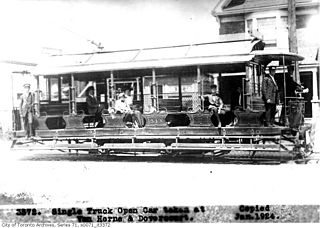
The Toronto Railway Company (TRC) was the operator of the streetcar system in Toronto between 1891 and 1921. It electrified the horsecar system it inherited from the Toronto Street Railway, the previous operator of streetcar service in Toronto. The TRC was also a manufacturer of streetcars and rail work vehicles, a few of which were built for other streetcar and radial operators.
The Toronto Suburban Railway was a Canadian electric railway operator with local routes in west Toronto, and a radial (interurban) route to Guelph.
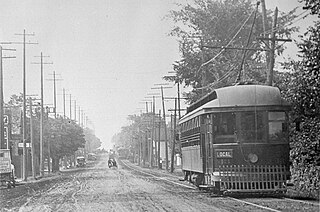
The Metropolitan line in the Toronto area, operated by the Metropolitan Street Railway, started out as a local horsecar line and transformed itself into an electric radial line extending to Lake Simcoe, following an old stage coach route. In 1904, the railway was acquired by the Toronto and York Radial Railway (T&YRR) and became the T&YRR Metropolitan Division. In 1922, the City of Toronto acquired the T&YRR and contracted Ontario Hydro to manage the four T&YRR lines including the Metropolitan. In 1927, the TTC took over the operation of the Metropolitan Line to Sutton, and renamed it the Lake Simcoe line. In 1930, the TTC closed the Metropolitan Line but shortly reopened the portion between Glen Echo and Richmond Hill operating it as the North Yonge Railways until 1948.

The North Yonge Railways was a radial railway line operated by the Toronto Transportation Commission from 1930 to 1948 between Glen Echo (Toronto) and Richmond Hill. The line was created by reopening the southern portion of the TTC's Lake Simcoe radial line that had closed in 1930.
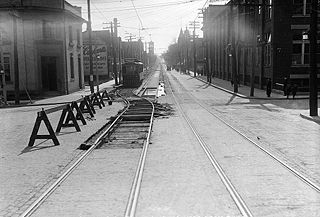
The history of public transportation in Toronto in Canada dates back to the middle 19th century under many different private companies, organizations and owners, which were all later unified as a single government-run entity during the 1920s.

The Urban Transportation Development Corporation Ltd. (UTDC) was a Crown corporation owned by the Government of Ontario, Canada. It was established in the 1970s as a way to enter what was then expected to be a burgeoning market in advanced light rail mass transit systems. It developed significant expertise in linear propulsion, steerable trucks and driverless system controls which were integrated into a transit system known as the Intermediate Capacity Transit System (ICTS). It was designed to provide service at rider levels between a traditional subway on the upper end and buses and streetcars on the lower, filling a niche aimed at suburbs that were otherwise expensive to service.

The Preston Car Company was a Canadian manufacturer of streetcars and other railway equipment, founded in 1908. The company was located in the town of Preston, Ontario. Preston sold streetcars to local transport operators including the Grand River Railway, the Toronto Railway Company and Toronto Civic Railways, and the Hamilton Street Railway. The company also sold a number of its distinctive ‘Prairie-style’ cars to operators in Alberta and Saskatchewan; one of these cars is being restored by the Saskatchewan Railway Museum. The Edmonton Radial Railway received 8 "Prairie" Prestons in 1909 and 1911 and 35 "Big" Prestons in 1913–14. Only a few Preston-built cars now remain, some of them in the collection of the Halton County Radial Railway museum. The Edmonton Radial Railway Society has in its collection "Prairie" Preston car 31 and "Big" Prestons numbers 53, 65 and 73.
Bombardier Transportation was a Canadian-German rolling stock and rail transport manufacturer, with headquarters in Berlin, Germany. It was one of the world's largest companies in the rail vehicle and equipment manufacturing and servicing industry. Bombardier Transportation had many regional offices, production and development facilities worldwide. It produced a wide range of products including passenger rail vehicles, locomotives, bogies, propulsion and controls. In February 2020, the company had 36,000 employees, and 63 manufacturing and engineering locations around the world. Formerly a division of Bombardier Inc., the company was acquired by French manufacturer Alstom on 29 January 2021.

The H series was the third series of rapid transit rolling stock used in the subway system of Toronto, Ontario, Canada. They were built in six production sets, named H-1 to H-6, from 1965 to 1990 in Thunder Bay, Ontario, for the Toronto Transit Commission (TTC).

The G series was the first rolling stock of rapid transit cars used on the Toronto subway, built 1953–1959 by the Gloucester Railway Carriage and Wagon Company of Gloucester, England, for the Toronto Transit Commission (TTC) of Toronto, Canada.

The T series, also known as the T-1, is the fourth series of rapid transit rolling stock used in the subway system of Toronto, Ontario, Canada. They were ordered by the Toronto Transit Commission (TTC) in 1992 and built in one production set between 1995 and 2001 by Bombardier Transportation in Thunder Bay, Ontario, Canada.

The Canadian Light Rail Vehicle (CLRV) and Articulated Light Rail Vehicle (ALRV) were types of streetcars used by the Toronto Transit Commission (TTC) from the late 1970s until the late 2010s. They were built following the TTC's decision to retain streetcar services in the 1970s, replacing the existing PCC streetcar fleet.

The Toronto Transit Commission version of the Peter Witt streetcar was designed by the Cleveland Street Railway in the United States and built under license by Canada Car and Foundry of Montreal. A small number were also built by the Ottawa Car Company and the Preston Car Company. Between 1921 and 1923, 575 of these streetcars were ordered by the TTC for use on Toronto streets.

The Presidents' Conference Committee Car was a streetcar used by the Toronto Transportation Commission and the Toronto Transit Commission. The PCC streetcar was designed by the Presidents' Conference Committee, a group of transit operators in the United States and Canada.
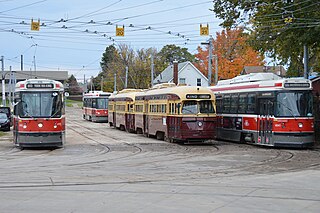
In 1921, the Toronto Transportation Commission (TTC) was created to integrate and operate the Toronto streetcar system. It inherited the infrastructure of two separate streetcar operators: the Toronto Railway Company (TRC) and Toronto Civic Railways (TCR). The TTC immediately embarked on a program to connect the TRC and TCR lines into one network. The TTC had to rebuild most of the track to provide a wider devilstrip so that the wider Peter Witt streetcars it was ordering could pass without sideswiping. Between 1938 and 1945, it placed five orders for air-electric PCC streetcars to replace the old, wooden streetcars of the TRC, and to address rising ridership. Between 1947 and 1951, the TTC placed three orders for all-electric PCC cars, with one order equipped with couplers for multiple-unit operation. Between 1950 and 1957, the TTC purchased PCCs from four American cities. By 1957, the TTC had more PCCs than any other city in North America. After the opening of the Bloor–Danforth subway in 1966, the TTC considered terminating all streetcar service in Toronto. However, in 1972, a citizens group led by Jane Jacobs and Steve Munro called "Streetcars for Toronto" persuaded the City to retain streetcar operation. This led to the development of the Canadian Light Rail Vehicle (CLRV) and its longer, articulated cousin, the Articulated Light Rail Vehicle (ALRV), to replace the aging PCC fleet. The Accessibility for Ontarians with Disabilities Act, 2005 (AODA) mandated that the next generation of streetcars be wheelchair-accessible. Thus, to replace the CLRVs and ALRVs, Bombardier adapted its low-floor Flexity Outlook model for the TTC to navigate the Toronto streetcar system's tight curves and single-point switches, characteristics set in 1921 to accommodate Peter Witt streetcars.
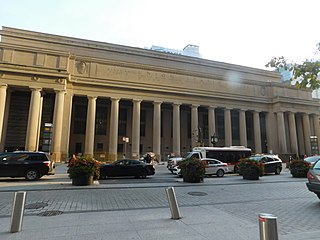
Public transportation in the Canadian city of Toronto dates back to 1849 with the creation of a horse-drawn stagecoach company. Today, Toronto's mass transit is primarily made up of a system of subways, buses, and streetcars, covering approximately 1,200 km (750 mi) of routes operated by the Toronto Transit Commission (TTC) and inter-regional commuter rail and bus service provided by GO Transit.

Toronto-gauge railways are tram and rapid transit lines built to Toronto gauge, a broad gauge of 4 ft 10+7⁄8 in. This is 2+3⁄8 in (60 mm) wider than standard gauge of 4 ft 8+1⁄2 in which is by far the most common track gauge in Canada. The gauge is unique to the Greater Toronto Area and is currently used on the Toronto streetcar system and the Toronto subway, both operated by the Toronto Transit Commission. As well, the Halton County Radial Railway, a transport museum, uses the Toronto gauge so its rail line can accommodate its collection of Toronto streetcars and subway trains. Several now-defunct interurban rail systems also once used this gauge.





















